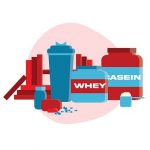Maintaining muscle health is crucial for overall well-being, as muscles play a fundamental role in nearly every function of the human body. Healthy muscles contribute to movement, stability, and posture, enabling us to perform daily activities with ease and reducing the risk of injuries. Beyond physical capabilities, muscles are integral to metabolic health, aiding in blood sugar regulation and supporting cardiovascular function. Strong muscles also enhance bone density, protect joints, and improve mental health by boosting mood and cognitive function. As we age, preserving muscle mass becomes even more critical to maintain independence and quality of life. Thus, prioritizing muscle health through regular exercise, balanced nutrition, and adequate rest is essential for leading a healthy and active life.
Body muscles are essential components of the human body, enabling movement, maintaining posture, and supporting vital functions. They can be broadly classified into three types: skeletal, cardiac, and smooth muscles. Here’s a detailed explanation of each type and their functions:
-
Skeletal Muscles
Skeletal muscles are the muscles attached to bones and are under voluntary control, meaning they can be consciously controlled to produce movement.
Characteristics:
- Striated Appearance: They have a striped (striated) appearance under a microscope due to the arrangement of actin and myosin filaments.
- Multinucleated: Skeletal muscle fibers have multiple nuclei.
- Voluntary Control: Movements are consciously controlled by the nervous system.
Functions:
- Movement: Skeletal muscles contract to produce movements such as walking, running, and lifting.
- Posture: They maintain body posture by providing support and stability.
- Heat Production: Muscle contractions produce heat, which helps maintain body temperature.
- Protection: They protect internal organs by providing a layer of padding.
-
Cardiac Muscles
Cardiac muscles are found only in the heart and are responsible for pumping blood throughout the body.
Characteristics:
- Striated Appearance: Similar to skeletal muscles, they appear striated due to the organized structure of muscle fibers.
- Involuntary Control: They contract involuntarily without conscious control.
- Single Nucleus: Cardiac muscle cells typically have one or two nuclei.
- Intercalated Discs: These specialized junctions between cardiac muscle cells allow for synchronized contractions.
Functions:
- Pumping Blood: Cardiac muscles contract rhythmically to pump blood from the heart to the rest of the body.
- Electrical Conductivity: They conduct electrical impulses that coordinate heartbeats.
-
Smooth Muscles
Smooth muscles are found in the walls of internal organs and blood vessels, and they operate involuntarily.
Characteristics:
- Non-Striated Appearance: Unlike skeletal and cardiac muscles, smooth muscles do not have a striated appearance.
- Single Nucleus: Smooth muscle cells typically have a single nucleus.
- Involuntary Control: They are controlled by the autonomic nervous system and hormones.
Functions:
- Movement of Substances: Smooth muscles contract to move substances through organs, such as food through the digestive tract, urine through the urinary tract, and blood through blood vessels.
- Regulation of Blood Flow: They control the diameter of blood vessels, thereby regulating blood flow and pressure.
- Organ Function: Smooth muscles in organs such as the stomach, intestines, and bladder help in their respective functions like digestion, nutrient absorption, and excretion.
Muscle Anatomy and Structure
Each muscle is made up of bundles of muscle fibers, which are composed of myofibrils. Myofibrils contain repeating units called sarcomeres, the basic functional units of muscle contraction, composed of actin (thin) and myosin (thick) filaments. The interaction between actin and myosin filaments, regulated by calcium ions and ATP, leads to muscle contraction.
Muscle Growth and Maintenance
- Hypertrophy: Muscle growth occurs when muscle fibers increase in size due to strength training and resistance exercises.
- Nutrition: Adequate protein intake and proper nutrition are essential for muscle repair and growth.
- Recovery: Rest and recovery are crucial for muscle repair and growth after exercise.
Understanding the different types of muscles and their functions helps in appreciating the complexity of the human body and the importance of maintaining muscle health through regular exercise, proper nutrition, and overall healthy lifestyle habits.
Health Benefits Of Muscle
Muscles play a crucial role in overall health and well-being. Here are some of the key health benefits of having strong, healthy muscles:
-
Improved Metabolism
- Increased Basal Metabolic Rate (BMR): More muscle mass means a higher BMR, leading to increased calorie burning even at rest.
- Enhanced Fat Burning: Muscle tissue burns more calories than fat tissue, aiding in weight management and fat loss.
-
Better Blood Sugar Regulation
- Glucose Uptake: Muscles help regulate blood sugar levels by absorbing glucose from the bloodstream, which can reduce the risk of type 2 diabetes.
- Insulin Sensitivity: Strength training improves insulin sensitivity, making it easier for the body to manage blood sugar levels.
-
Enhanced Physical Function
- Strength and Endurance: Strong muscles improve overall physical strength and endurance, making daily activities easier and reducing fatigue.
- Balance and Stability: Muscle strength, particularly in the core and lower body, enhances balance and stability, reducing the risk of falls and injuries.
-
Bone Health
- Bone Density: Weight-bearing exercises that build muscle also stimulate bone growth, improving bone density and reducing the risk of osteoporosis.
- Joint Support: Strong muscles support and protect joints, reducing the risk of joint injuries and conditions like arthritis.
-
Cardiovascular Health
- Improved Circulation: Muscular activity helps promote healthy blood flow and circulation, reducing the risk of cardiovascular diseases.
- Heart Strength: Regular physical activity, including resistance training, strengthens the heart muscle, improving overall heart health.
-
Mental Health Benefits
- Mood Enhancement: Exercise, including strength training, releases endorphins, which can improve mood and reduce symptoms of depression and anxiety.
- Cognitive Function: Regular physical activity has been linked to improved cognitive function and a reduced risk of cognitive decline and dementia.
-
Increased Longevity and Quality of Life
- Healthy Aging: Maintaining muscle mass as you age helps preserve mobility, independence, and overall quality of life.
- Reduced Mortality Risk: Higher muscle mass and strength are associated with a lower risk of premature death from all causes.
-
Injury Prevention and Rehabilitation
- Injury Prevention: Strong muscles provide better support to the body, reducing the likelihood of injuries during physical activities.
- Faster Recovery: Having a good muscle base can help speed up recovery from injuries and illnesses by improving overall body strength and resilience.
-
Functional Capacity
- Daily Activities: Strong muscles make it easier to perform everyday tasks such as lifting, carrying, and moving.
- Athletic Performance: Improved muscle strength and endurance enhance performance in sports and other physical activities.
Incorporating strength training and resistance exercises into your fitness routine can help build and maintain muscle mass, leading to these numerous health benefits.
READ MORE: How To Build Muscle Fast for Skinny Guys
Sources:
https://my.clevelandclinic.org/health/body/21887-muscle
https://www.physio-pedia.com/Myofibril
https://newsinhealth.nih.gov/2020/03/maintain-your-muscle
https://compurocare.com/muscle-matters-10-health-benefits-of-increased-muscle-mass/









